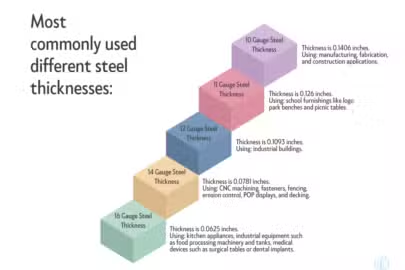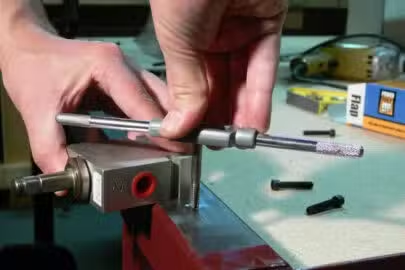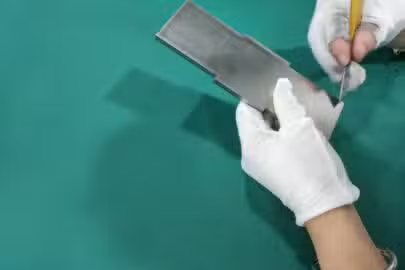Aluminum is one of the most popular metals used in metal product manufacturing for many industries. It is a versatile material with several beneficial properties that make it suitable for many applications. However, it is crucial to choose the right manufacturing process when designing aluminum parts. Among the several available processes, die casting aluminum stands out.
Aluminum die casting is an effective manufacturing technique for producing precise, smooth, and textured metal parts. This method involves the injection of molten metals into molds under high pressure. The lightweight properties and exceptional dimensional stability of aluminum make it a favored alloy for this technique.
If you’re curious about the fundamentals of the diecast aluminum process, this article is for you. We will cover the benefits and applications of the process.
What Is the Aluminum Die Casting Process?
The aluminum die casting process is a method used to create metal parts by heating and melting aluminum at high temperatures and injecting it into pre-shaped molds.
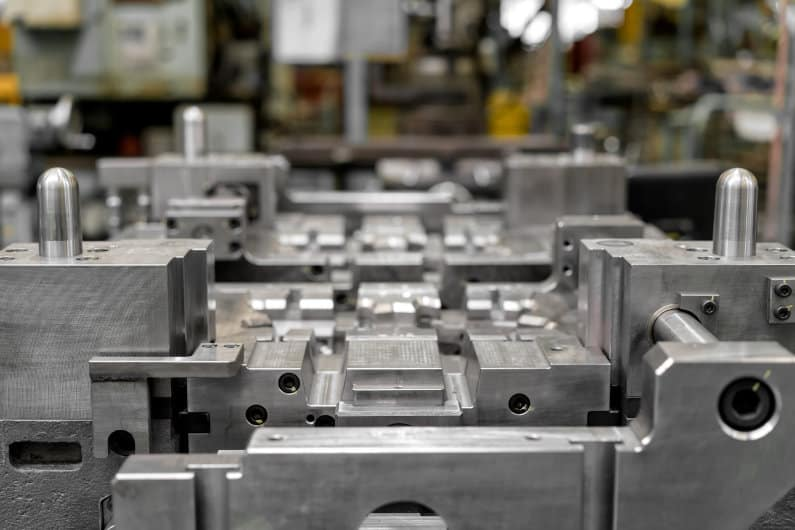
The key principles include the following:
- Mold Design: The mold is precisely designed with two halves – the ejector half (ejector die) and the fixed half (cover die). Once these halves have been machined, they are used to form the desired part’s shape.
- Melting and Injection: Molten aluminum is heated and injected into the mold cavity under extremely high pressure, ensuring complete filling and shaping.
- Cooling and Solidification: After injection, the molten aluminum is left to cool and solidify within the mold.
- Ejection and Finishing: Once the aluminum has cooled, the mold is opened, and the part is ejected. Further finishing processes like trimming or surface treatments may be applied.
Die casting machines, regardless of their size, primarily differ in the method used to complete the process. There are two major methods:
Hot Chamber Die Casting
Hot chamber die casting employs the same method mentioned earlier, where molten metal is pressurized into a pre-shaped mold cavity. What sets hot-chamber die casting apart is that the metal is heated within the casting machine, not in a separate furnace. These machines are often referred to as goose-neck machines.
They have an integrated furnace for heating the metal to a molten state. A hydraulic-powered piston then propels the molten metal from the furnace into the die. This process is relatively quick, typically taking just 15 to 20 minutes for a full cycle.
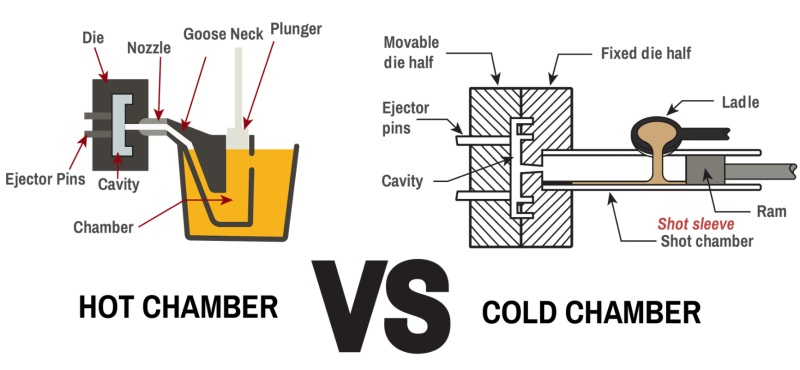
Cold Chamber Die Casting
Cold chamber die casting might sound like it involves forcing cold metal through a mold, but it still requires the injection of molten metal. The key difference lies in the heating process. In cold-chamber die casting, the die cast metals are initially heated to a molten state in a separate furnace. The molten metal is then introduced into the casting machine’s chamber. A pressurized plunger within the machine propels the molten metal into the mold cavity.
Cold-chamber die casting is necessary for certain high-melting-point metals like aluminum. These alloys require a separate furnace due to the elevated temperatures needed to achieve a molten state. This distinction prompts some manufacturers to choose cold-chamber die casting over its hot-chamber counterpart.
Advantages of Die Casting Aluminum
The lightweight nature of aluminum makes it most suitable for aluminium die casting, as it enables the production of lightweight components while maintaining durability. Let’s delve into some key advantages of this die casting method.
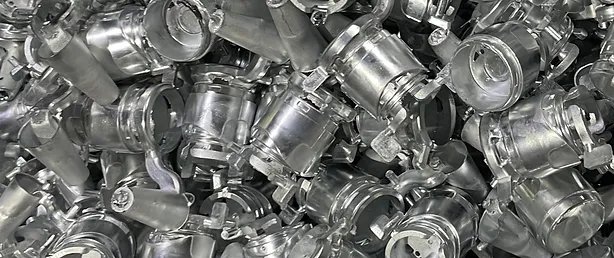
Cost-Effective for Large-Volume Production
Die casting parts demand minimal, or in some cases, no subsequent machining. This capacity to eliminate the need for post-processing stands as a notable advantage of the die casting method. Consequently, businesses can streamline large-scale production without allocating extra resources for finishing.
Furthermore, the casting cycle in die casting aluminum is notably short compared to alternative methods. Molten metals solidify in a matter of seconds, rendering the mass production of components through this process highly cost-effective.
Excellent Mechanical Properties
Die casting imparts outstanding mechanical characteristics to its fabricated components. The high-pressure solidification of molten aluminum results in finely structured, compact, and crystalline products. These die casting parts exhibit rigidity, hardness, and remarkable strength. In addition to these attributes, they offer enhanced durability and exceptional conductivity.
Dimensional Accuracy
Aluminum die casting yields robust and dimensionally stable components that can withstand even severe conditions while retaining their precision. Consequently, it is the preferred choice for crafting intricate and internal machine parts that demand exacting standards of accuracy. Furthermore, die castings consistently achieve tighter tolerances than alternative casting methods. Notably, these products do not require additional machining to enhance their dimensional stability.
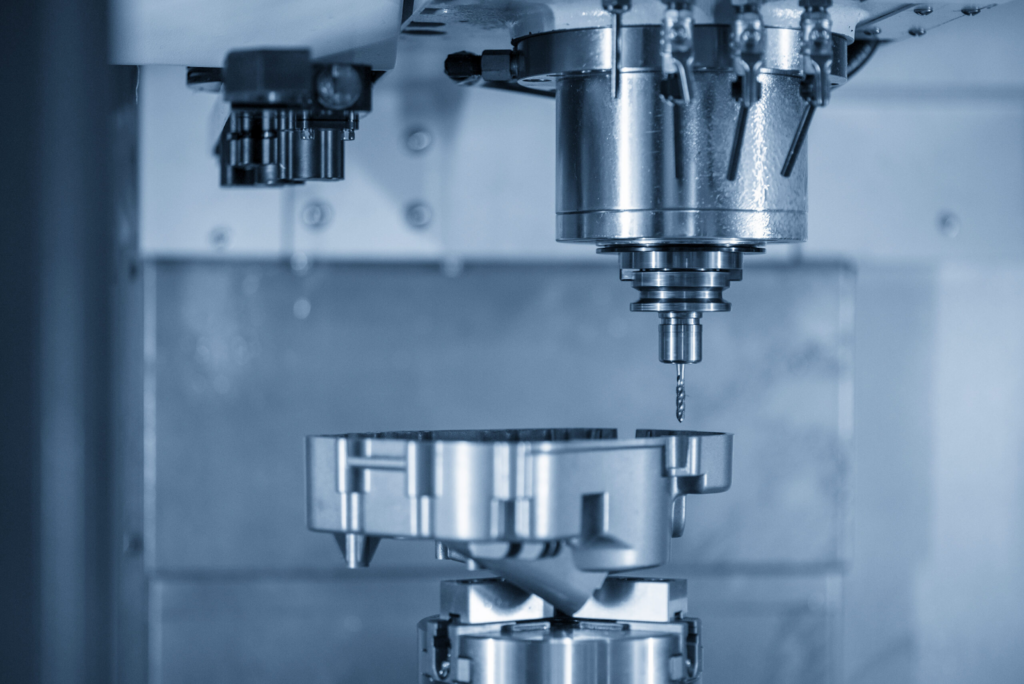
Machining Complex Parts
Die casting aluminum excels in producing intricate, thin-walled components, distinguishing it from other metal molding techniques. Notably, aluminum alloys are the favored materials for crafting such thin-walled parts, as they deliver exceptional strength-to-weight ratios. In die casting, parts made from aluminum alloys can achieve a remarkable thickness of as little as 0.5mm.
Smooth Surface Finish
Die castings boast uniformly smooth crystalline surfaces. As the molten metal takes on the precise shape of the dies, the resulting castings exhibit fine and polished finishes. This is a notable advantage of die casting, minimizing the necessity for subsequent post-processing steps. In fact, products can be promptly dispatched for delivery immediately after the die-casting process is completed.
Common Die Cast Aluminum Alloys
There are many aluminum alloys ideal for the die casting technique. However, an alloy must have certain features to make it a suitable candidate for aluminium die casting. These characteristics help engineers create aluminum die cast with great flexibility.
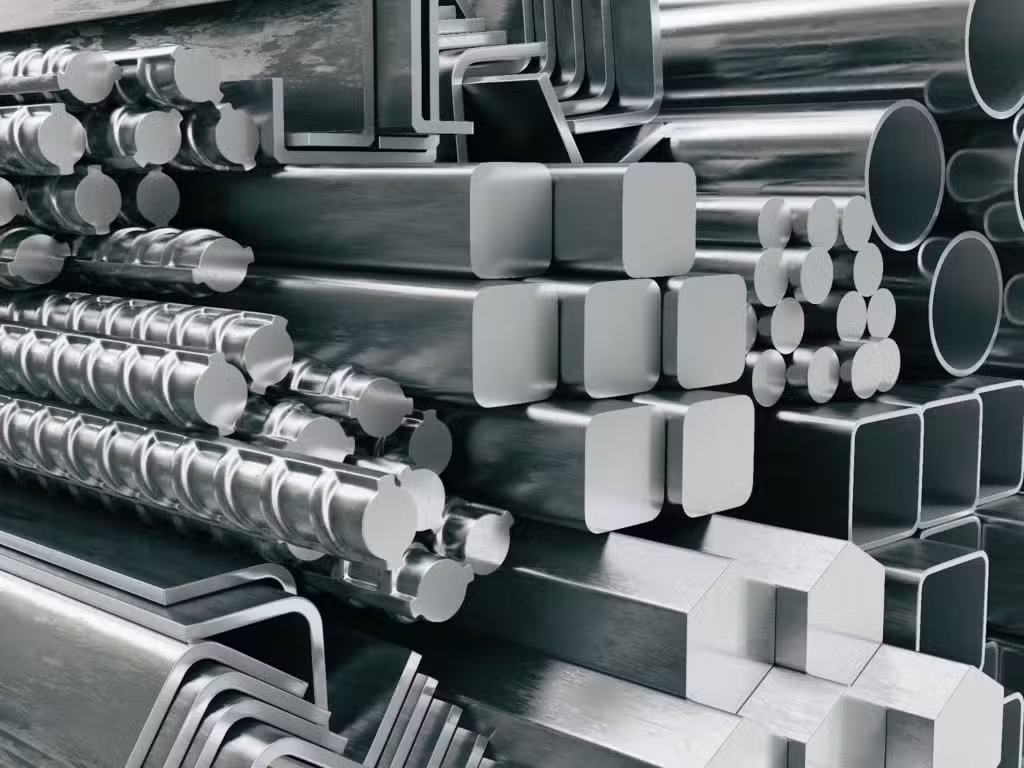
They include the following:
- Corrosion resistance
- Excellent strength-to-weight ratio
- Good finishing characteristics
- High operating temperatures
- Excellent stiffness
- Outstanding thermal and electrical conductivity
- RFI and EMI shielding
- Full recyclability
The table below summarizes the aluminum alloys suitable for metal die casting and their applications:
| Alloy | Properties | Typical Applications |
| ADC-1 | High fluidity, good castability, and corrosion resistance. | Electrical components, lighting fixtures, and decorative castings. |
| ADC3(A360) | Good formability and corrosion resistance, excellent air tightness | Automobile oil pans, automobile controller casings, motor casings, 5g communication boxes, LED lamp casings. |
| ADC6 | Good thermal brittleness, corrosion resistance, oxidative coloring, excellent strength and hardness, | Aircraft parts and missile casings |
| ADC10 | Good fluid flow and mechanical properties | Electronic enclosures and radiators |
| ADC12 | Good corrosion resistance, high fluidity, excellent pressure tightness, and good castability, excellent machinability, high strength. | Automotive parts, including engine blocks, transmission cases, and heat sinks. |
| A413 | Superior pressure tightness, exceptional strength, ideal corrosion resistance, very low specific gravity, excellent mold filling performance, good flowability and pressure sealing | Aircraft structural parts, engine parts |
| B390 | Best combination of casting, mechanical and thermal properties, excellent flow, pressure sealing and thermal crack resistance | Electronic equipment chassis, engine mounts, transmission cases, household furniture, power and hand tools |
| AC43500 | High strength, excellent corrosion resistance, and good processability | Engine casing, starter frame and fuselage structure |
| A356 | Light weight, good pressure tightness and excellent mechanical properties | Aircraft, pump casings, impellers, truck chassis parts, high speed blowers and impellers |
Common Die Casting Defects
Die casting defects are generally divided into internal defects and external defects. The common ones include the following:
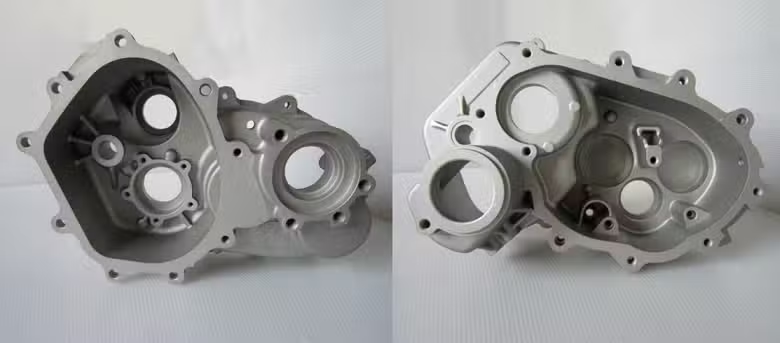
- Gas Porosity: Gas porosity results from the formation of bubbles within the cast during cooling, appearing as round or oval structures with smooth, bright surfaces. It occurs as dissolved gas in liquid metal forms voids upon cooling.
- Shrinkage Porosity: This defect happens during casting’s cooling and solidification, potentially distorting shapes or creating holes. It manifests as angular edges with cracks or dendritic fractures.
- Inclusions: Inclusions are irregular holes inside or on the casting’s surface. This is often caused by impurities from metal, metal interaction with the atmosphere or mold surface, low furnace charge purity, and excessive graphite in mold release agents.
- Cracks: Cracks occur due to stress within and outside the material during cooling and external forces during ejection, with irregular or linear patterns on the casting surfaces. They result from improper alloying elements, requiring the use of correct alloy elements, optimizing component structure, and ensuring uniform wall thickness.
- Cold Shut: It appears as irregular linear lines on the cast’s surface, caused by the improper fusion of two liquid metal fronts. Prevention involves increasing mold and molten metal temperatures, altering gate size and position, and enhancing plunger speed.
- Network Cracks: These are hair- or net-like depressions on the casting surface. It may occur due to a high filling temperature, rough die cavity, improper material choice, and inadequate heat treatments.
- Flashes: They create thin, irregular metal sheet shapes on the casting and are caused by high injection speed, temperature, unclean surfaces, and insufficient die clamping force.
- Deformation: This happens when the final part shape does not match the drawing. It is caused by improper gate removal, premature mold opening, cast design, rags during casting ejection, and inadequate ejection mechanisms.
- Flow Marks: Flow marks appear as stripes or non-directional lines on the casting surface due to low die temperature, excess lubricant, filling pressure, and small cross-sectional areas.
- Laminations: They occur from the overlap of two layers during the filling process, causing hidden substances between layers. They can be addressed through proper insert design and handling.
- Sinks: These defects manifest as depressions in the casting’s thick-walled areas due to low injection pressure, partial die overheating, uneven wall thickness, and short pressure-holding times.
Surface Finishing Options for Aluminum Die Cast Parts
While aluminum die casting parts require very minimal post-processing, there are situations when you have to perform surface finishing for improved functionality and aesthetics. In such situations, here are the most preferred options:
Anodizing
Anodizing aluminum die castings offers an economical solution for enhancing their corrosion resistance and durability. It creates a non-conductive protective layer on the components. Despite aluminum’s natural conductivity, the oxide layer acquires ceramic-like properties, rendering the anodized diecast aluminum non-conductive.
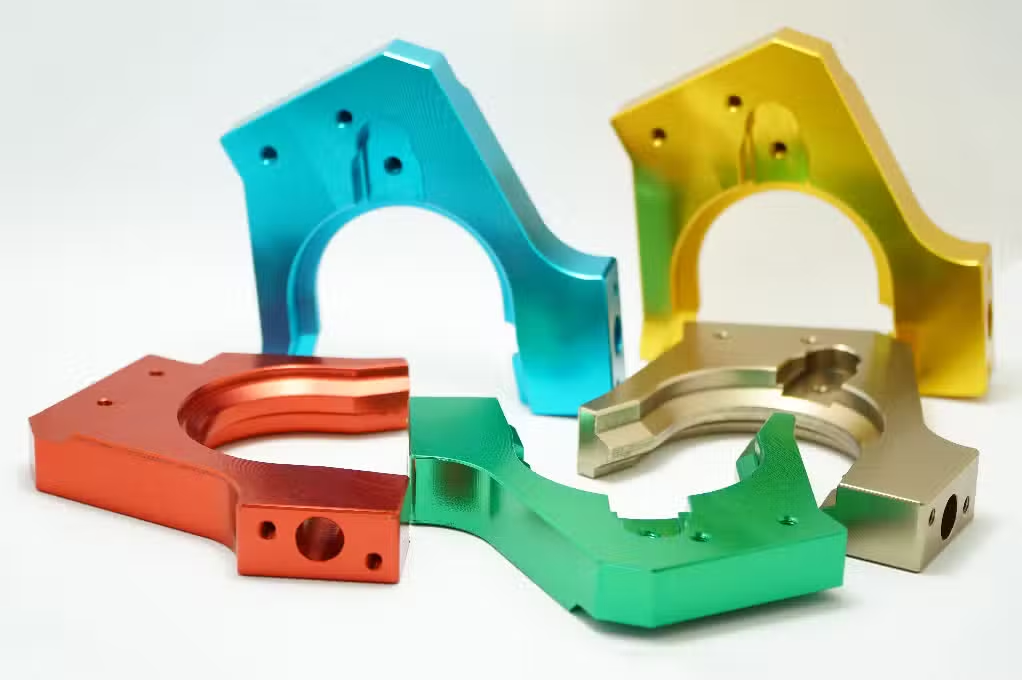
Nonetheless, anodized aluminum exhibits restricted electrical conductivity upon direct contact. This limitation arises from the thinness of the surrounding oxide layer, resulting in significantly lower conductivity. If your application demands electrical conductivity through aluminum, it’s advisable to explore alternative surface finish options.
Powder Coat
Powder coating stands out as a widely favored surface finishing technique for aluminium die casting components. This process involves high-temperature application and requires a certain level of durability. However, it offers excellent resistance to dings and scratches. Moreover, it provides a diverse range of options in terms of textures, colors, and gloss levels.
Electroplating
This technique involves the depositing a thin metallic coating onto the surface of a casting by means of an electrolytic setup. This method is excellent for improving both the functionality and visual appeal of many products. It has an excellent range of customization options, and it is suitable for large-scale products.
Painting
Methods like painting are well-suited for die-cast components due to application ease and ability to offer protection and improved aesthetics. However, it is crucial to consider the specific type of paint finish required for your products during the design phase.
To achieve optimal results, take precautions and eliminate contaminants like oils from the cast surfaces before applying the paint. Additionally, you can enhance adhesion by applying a conversion coating to the prepared surface after thorough cleaning.
Chemical Film
Chem Film is a widely favored surface finishing choice for aluminum die-cast materials. It can be applied with different methods, such as spraying, brushing, or dipping. The key distinction of this process is its electrical conductivity, making it applicable in many industries.
Applications of Aluminum Die Casting Parts
Aluminum alloys offer outstanding mechanical advantages, leading to their widespread use across various applications. As more industries adopt aluminum die-casting, new applications continue to emerge. Here are some notable applications of the aluminum die-casting process:
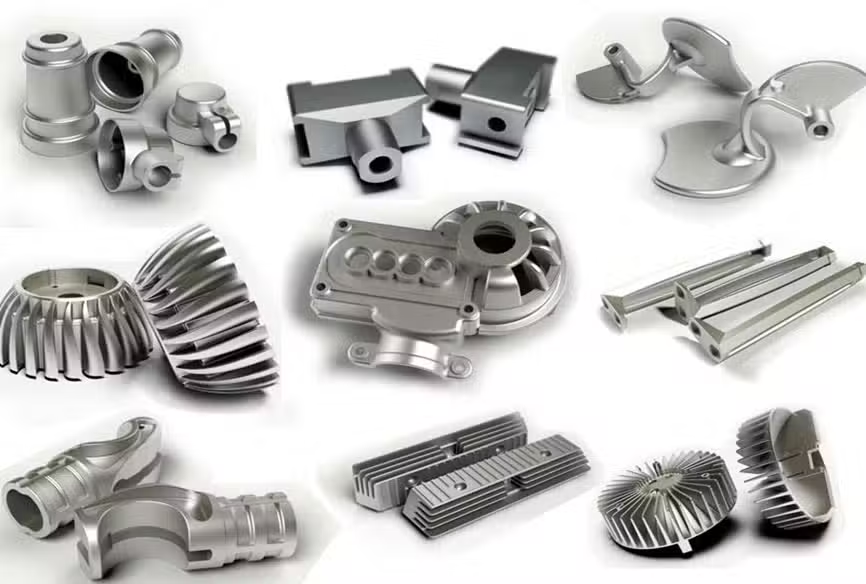
Automotive
The lightweight nature of aluminum alloys makes them a crucial component in modern vehicles. They find extensive use in the automotive industry, spanning various applications from engines to body parts to enhance fuel efficiency. Despite their reduced weight, these aluminum components maintain exceptional durability and strength. Moreover, aluminum alloys offer environmental benefits, as many automotive aluminum scrap can be efficiently recycled.
Electronics Industry
In the last two decades, the electronics industry has witnessed unprecedented growth and remarkable innovation in consumer products. Central to this progress has been the pivotal role played by aluminum in manufacturing these items. Die-cast aluminum alloys, in particular, are integral in developing various consumer products. They span from smartphones to the housing of 5G networks and many more.
Aerospace Industry
Similar to the automotive sector, the aerospace industry also demands lightweight and impact-resistant materials for its intricate tools and high-tensile structural components. This is where aluminum die casting materials find extensive utility. These include airplane engine piston heads, fuel system components, cargo loading housings, distributor cap housings, electronic enclosures, lighting fixture elements, dentition ring components, etc.
Medical Industry
The medical industry relies on aluminum casting to achieve lightweight and robust components, such as surgical trays and prosthetics. Aluminum die casting’s ability to fabricate intricate and precise geometries is particularly valuable in this field. Furthermore, aluminum’s corrosion resistance is advantageous for medical equipment frequently exposed to bodily fluids and chemicals.
Construction
Aluminum casting alloys are essential materials in the construction industry. They are commonly employed in applications such as window frames and roof superstructures. Additionally, engineers rely on die-cast aluminum components to construct large structures, including commercial buildings and bridges.
Considerations for Designing Aluminum Die Casting Parts
There are some measures you need to put in place during aluminum die casting parts design. This will help you get the best results from the metal die casting project. Here are the essential considerations:
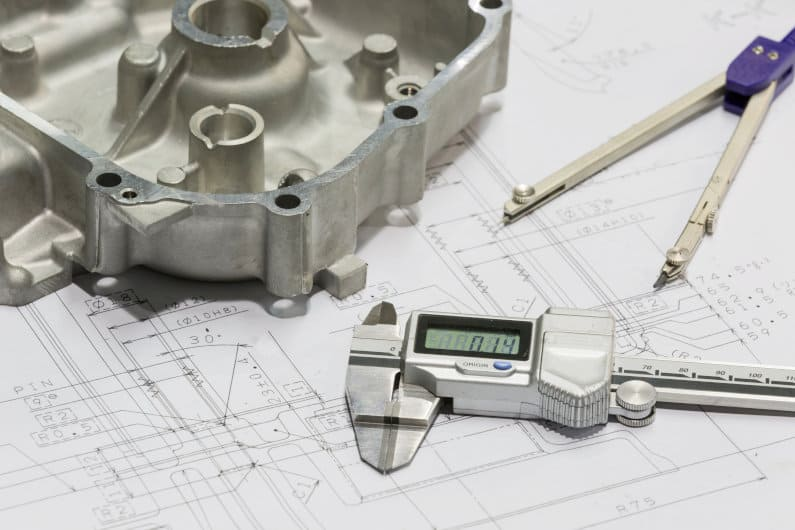
Mold Design
One of the initial key considerations is mold design. Efficiency is crucial, allowing for the seamless injection of molten aluminum and easy ejection of the finished parts. Each mold features a parting line, the division point between its two halves. Designers must ensure to address this factor in the early stages of the die design process.
Location of Injection Point
It is important to incorporate multiple injection points into the design to prevent premature solidification of molten aluminum before it reaches all the intricate sections within the die. This approach is beneficial when dealing with complex cavities. It allows you to surround these areas in aluminum while ensuring that the part can be easily removed upon mold separation.
Wall Thickness
As a product designer, it is crucial to consider the wall thickness of your mold carefully. This factor is pivotal in minimizing material wastage, expediting production, and ensuring the quality of the end products. Designing thin walls can impede the proper flow of molten metal within the mold, leading to premature solidification before complete filling. Conversely, excessively thick walls result in material wastage, extended solidification times, increased part weight, and the loss of the high-speed production advantage. Moreover, overly thick walls compromise the flexibility and quality of aluminum cast parts.
Maintaining a consistent wall thickness is essential for enhancing the structural integrity and overall quality of the casting. The recommended wall thickness for aluminum castings typically falls within the range of 0.787″ to 0.1737″. However, this dimension may vary based on factors such as the material, structure, size, and application of the die-cast part.
ZINTILON On-Demand Aluminum Die Casting Service

ZINTILON provides highly precise custom aluminum die casting services with rapid turnaround times. Our capabilities cover the production of various aluminum parts, from small components to larger, more complex structures. Our team consists of industry-experienced professionals who are dedicated to achieving the best results in your project. Whether you require prototyping or large-scale production, we offer an affordable and efficient service.
Our factory is equipped with cutting-edge technology, featuring automated machines and robots that ensure precision and consistency in our manufacturing processes. We are ISO 9001 certified, and we adhere to rigorous industry standards throughout the production of your die-cast components.
Conclusion
Die casting aluminum is an excellent manufacturing technique. However, it can become costly when dealing with small quantities of parts. However, as the quantity of parts increases, die-casting emerges as the most economically viable process. Manufacturers often favor aluminum due to its unique properties, and its lower material costs contribute to improved profit margins.
ZINTILON’s professional die casting service ensures precision in delivering your designed parts. Furthermore, we extend cost-saving opportunities to meet the needs of our global clientele. Please contact our support team to answer your inquiries. If you have a project in mind, request a quote to get started.
